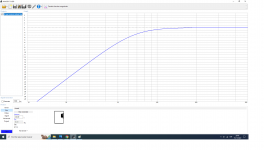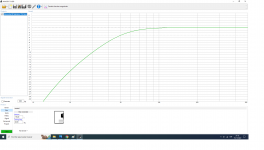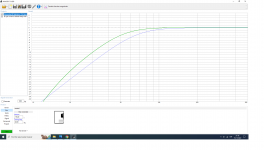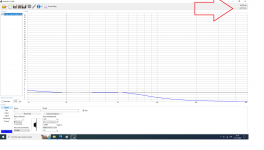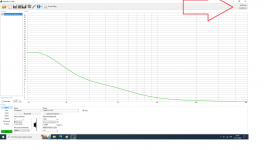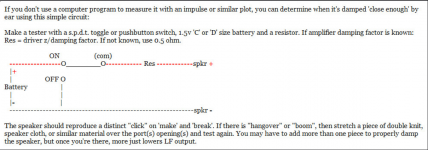Ok, I guess I'm a bit mentally inactive and chess just bores me 🙄 , so I'm playing with Win Isd to see what would happen if I converted my two sealed subwoofers (which I built and documented here at Diy Audio ) to bass reflex ...
So I will upload different graphs and ask about the opinion of the experts.
So I will upload different graphs and ask about the opinion of the experts.
You gain boomy bass, some like it, some don't.
What are the drivers if you don't mind my asking?
Important fact, of course, Eminence Delta Pro 18 A, (out of production) the one I was able to buy at the time. Of course, there are better speakers but that will not be the subject under discussion here.
Maybe I'm missing something but it seems like you linked the wrong graph. That looks like the response of the mains and not the sub...
Correct, but I listen to it too dry, and I notice that I like a BR that I also built a long time ago.....You gain boomy bass, some like it, some don't.
It is the correct graph, look at the frequencies it covers.Maybe I'm missing something but it seems like you linked the wrong graph. That looks like the response of the mains and not the sub...
It is to complement the network speakers and I am only interested in the first octaves. I crossover with DSP at 80 Hz.
It's a prosound (bass) horn driver spec-wise, nowadays more often used for small, high power prosound mid-bass BRs, so has a naturally high box tuning.
Good question. I've dabbled in this for a while.
My 'general' observations:
May I ask, is your main listening two-channel hi-fi or home theatre/stereo combined?
Have you considered different room placement for the existing subs to see if this gives a noticeable improvement in sound quality?
Of course, if you wanted effortless/rich bass, you could consider something substantial like a tapped horn or a Bill Fitzmaurice Tuba sub..., which I can attest to.
My 'general' observations:
- sealed boxes offer a 'cleaner' sound (less affected by port turbulence etc)....so maybe better for hi-fi/music listening vs HT applications
- ported boxes offer lower frequencies (for the same driver / box size), so better if you don't need to overly EQ a woofer in a sealed box to obtain the same result.
- ported boxes to have a different sound, less 'tight/dry.'
May I ask, is your main listening two-channel hi-fi or home theatre/stereo combined?
Have you considered different room placement for the existing subs to see if this gives a noticeable improvement in sound quality?
Of course, if you wanted effortless/rich bass, you could consider something substantial like a tapped horn or a Bill Fitzmaurice Tuba sub..., which I can attest to.
Precisely because of what you say, Eminence did not make "Sealed" construction graphics available, it directly appeared N/A.It's a prosound (bass) horn driver spec-wise, nowadays more often used for small, high power prosound mid-bass BRs, so has a naturally high box tuning.
He is a 4 layer voice coil driver, I emailed Jerry from Eminence and he explained that detail that was not in the specs.
Also gain the potential for port noise. I've tried both and simply won't build ported boxes any more.You gain boomy bass, some like it, some don't.
Your assessments are correct and I know them.Good question. I've dabbled in this for a while.
My 'general' observations:
- sealed boxes offer a 'cleaner' sound (less affected by port turbulence etc)....so maybe better for hi-fi/music listening vs HT applications
- ported boxes offer lower frequencies (for the same driver / box size), so better if you don't need to overly EQ a woofer in a sealed box to obtain the same result.
- ported boxes to have a different sound, less 'tight/dry.'
May I ask, is your main listening two-channel hi-fi or home theatre/stereo combined?
Have you considered different room placement for the existing subs to see if this gives a noticeable improvement in sound quality?
Of course, if you wanted effortless/rich bass, you could consider something substantial like a tapped horn or a Bill Fitzmaurice Tuba sub..., which I can attest to.
At one point I used it for both (HT and HI FI), now only music, but I ask you for a little patience, let me develop the idea, now comes the best, the comparisons that may be more important than FR, such as delay group, VC excursion and power admission.
Thanks for responding so promptly.
Are you adding any EQ to the sealed subs? If so add that to the simulation and recompare group delay.
As for tthe boomy bass comment that entirely depends on the combined box/room response, a well integrated sub should just extend the systems lowend respose lower regardless of type.
As for tthe boomy bass comment that entirely depends on the combined box/room response, a well integrated sub should just extend the systems lowend respose lower regardless of type.
Last edited:
such an unfair answer sir!?😳You gain boomy bass, some like it, some don't.
Sorry, all my subs are either open baffle or sealed. Can't stand resonances involved.
Reminds me of car audio people, one note samba. Boom boom, no matter what music is on.
Reminds me of car audio people, one note samba. Boom boom, no matter what music is on.
- Home
- Loudspeakers
- Subwoofers
- Sealed subwoofer to bass reflex, what do I gain and what do I lose ?
